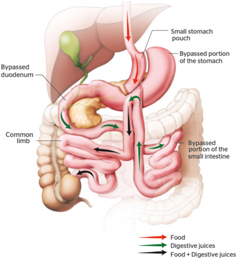
The One Anastomosis Gastric Bypass (OAGB) is one of three main types of bypass procedure. (The other bypass procedures are the Roux-Y and SADI). Also known as the Mini-Bypass or the Omega loop, it was developed in the late 1990’s as a means of reducing some of the longer term problems occasionally seen with the other bypasses, especially internal hernia, intermittent abdominal pain, and bowel obstruction. It also appears to have less issues with Dumping Syndrome.
Like the other types of bypass, the One Anastomosis Mini Gastric Bypass is a combined restrictive/metabolic surgical procedure. It is restrictive in the sense that it ‘restricts’ how much food the stomach can hold and is ‘metabolic’ in that it influences gut hormones, blood sugar regulation, and metabolism. This combination allows for very powerful weight control and significant improvement in metabolic problems associated with obesity such as hyperlipidaemia (raised cholesterol) and diabetes.
The One Anastomosis Mini Gastric Bypass is also frequently performed as a revision procedure to address weight regain after a previous gastric band or sleeve.
It is performed laparoscopically (keyhole), using 5 small incisions. A small stomach pouch less than a cup in size is made by dividing the stomach using surgical staplers. The bottom of the pouch is then surgically joined part of the way down the small intestine, bypassing the first 1.5m.
The procedure takes approximately 1 hour, and post op recovery is quick; and you will be able to walk comfortably and drink a wide variety of fluids including coffee, juices and soup that afternoon. One night in hospital is sufficient, and patients can drive after 3 days, and generally return to work and everyday life after 5-7 days.
The One Anastomosis Mini Gastric Bypass is highly effective with multiple studies reporting continued weight control at several years and beyond. It is also especially good at treating diabetes, which will improve in the majority of cases, and even achieve complete remission in many instances. Another advantage is that it can be easily reversed if required.
However, because some of the small intestine is bypassed, there may be a reduction in the absorption of certain micronutrients and vitamins, and therefore ongoing vitamin supplementation and monitoring are important. Bile reflux, ulcers on the surgical join, and changes to bowel habit are also possible side effects in up to 10% of patients.
Am I eligible?
To be considered for the One Anastomosis Mini Gastric Bypass you will need to have a Body Mass Index of at least 35. CHECK YOUR BMI
The One Anastomosis Mini Gastric Bypass may be especially appropriate for you if your BMI is greater than 45, or you have poorly controlled type 2 diabetes regardless of your BMI.
What are the risks of One Anastomosis Mini Gastric Bypass?
As with any surgery there are potential risks involved. Whilst most patients do not have any problems after One Anastomosis Mini Gastric Bypass, complications can sometimes occur, and occasionally be quite serious. Recovery and outcome may depend on the patient’s existing health status. Specific complications of the One Anastomosis Mini Gastric Bypass include:
- Short term surgical risks may affect up to 1% of patients and include leakage from staple lines or anastomoses, blood clots, bleeding and anaesthetic complications
- Long term issues include bile reflux, loose bowels, vitamin deficiencies, gallstones, twisting of the intestine, and marginal ulcers (ulcer forming on the anastomosis)
Come in for your consultation where we will discuss the One Anastomosis Mini Gastric Bypass in more detail including benefits and risks.
